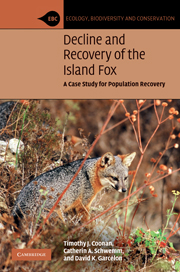Book contents
- Frontmatter
- Contents
- Foreword
- Acknowledgments
- 1 Introduction
- 2 Evolution and genetics
- 3 Social structure, reproduction, mortality and survivorship, and population dynamics
- 4 Food habits, habitat use, activity patterns, and dispersal
- 5 Golden eagles and the decline on the northern islands
- 6 Ecosystem recovery
- 7 Disease and decline on Santa Catalina Island
- 8 Recovery actions
- 9 Recovery actions
- 10 Reproductive biology, by Cheryl Asa
- 11 Diseases of island foxes, by Linda Munson
- 12 Zoos, education, and public participation
- 13 Managing recovery
- 14 The ecological role of island foxes
- 15 Conclusion
- References
- Index
5 - Golden eagles and the decline on the northern islands
Published online by Cambridge University Press: 05 October 2010
- Frontmatter
- Contents
- Foreword
- Acknowledgments
- 1 Introduction
- 2 Evolution and genetics
- 3 Social structure, reproduction, mortality and survivorship, and population dynamics
- 4 Food habits, habitat use, activity patterns, and dispersal
- 5 Golden eagles and the decline on the northern islands
- 6 Ecosystem recovery
- 7 Disease and decline on Santa Catalina Island
- 8 Recovery actions
- 9 Recovery actions
- 10 Reproductive biology, by Cheryl Asa
- 11 Diseases of island foxes, by Linda Munson
- 12 Zoos, education, and public participation
- 13 Managing recovery
- 14 The ecological role of island foxes
- 15 Conclusion
- References
- Index
Summary
Island fox populations on San Miguel, Santa Rosa, and Santa Cruz Islands underwent severe and unprecedented declines in the 1990s. Island fox populations on all three islands were naturally small and had historically fluctuated, but as far as was known had never been as low as they were during this period and had never come close to extinction. The source (or sources) of the mortality that was causing the declines was at first elusive; a species-wide investigation revealed no evidence of disease, and no significant changes in food supply or habitat condition were detected. Radiotelemetry studies of foxes on Santa Cruz and San Miguel ultimately revealed evidence of predation by golden eagles, a species which had not previously bred on the islands and was, until this time, rarely observed. Fox mortality rates due to predation were so high that by 1999 the San Miguel and Santa Rosa fox subspecies were nearing extinction; on each of those islands total abundance had declined from approximately 450 and 1,500, respectively, to 15. The remarkable influence of golden eagle predation on island fox populations was due to the success of golden eagles in colonizing the northern Channel Islands (supported by introduced prey species), and the vulnerability of island foxes to predators with which they had not evolved.
Detecting change
Prior to the 1990s, the island fox populations on San Miguel, Santa Rosa, and Santa Cruz were thought to have fluctuated over time, perhaps markedly, but never to near-extinction levels.
- Type
- Chapter
- Information
- Decline and Recovery of the Island FoxA Case Study for Population Recovery, pp. 43 - 57Publisher: Cambridge University PressPrint publication year: 2010



